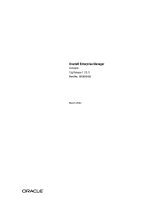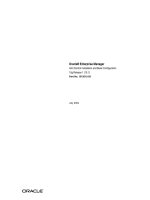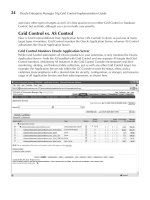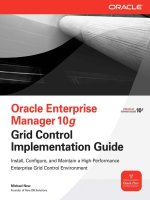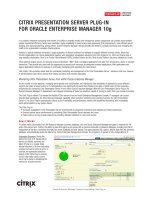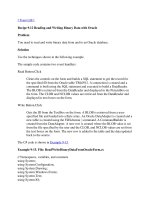middleware management with oracle enterprise manager grid control 10g r5
Bạn đang xem bản rút gọn của tài liệu. Xem và tải ngay bản đầy đủ của tài liệu tại đây (10.05 MB, 332 trang )
www.it-ebooks.info
Middleware Management with
Oracle Enterprise Manager
Grid Control 10g R5
Monitor, diagnose, and maximize the system
performance of Oracle Fusion Middleware solutions
Debu Panda
Arvind Maheshwari
BIRMINGHAM - MUMBAI
This material is copyright and is licensed for the sole use by Alison Voyvodich on 4th December 2009
12593 80th Avenue N, , Seminole, , 33776
www.it-ebooks.info
Middleware Management with Oracle Enterprise
Manager Grid Control 10g R5
Copyright © 2009 Packt Publishing
All rights reserved. No part of this book may be reproduced, stored in a retrieval
system, or transmitted in any form or by any means, without the prior written
permission of the publisher, except in the case of brief quotations embedded in
critical articles or reviews.
Every effort has been made in the preparation of this book to ensure the accuracy
of the information presented. However, the information contained in this book is
sold without warranty, either express or implied. Neither the authors, nor Packt
Publishing, and its dealers and distributors will be held liable for any damages
caused or alleged to be caused directly or indirectly by this book.
Packt Publishing has endeavored to provide trademark information about all of the
companies and products mentioned in this book by the appropriate use of capitals.
However, Packt Publishing cannot guarantee the accuracy of this information.
First published: November 2009
Production Reference: 2241109
Published by Packt Publishing Ltd.
32 Lincoln Road
Olton
Birmingham, B27 6PA, UK.
ISBN 978-1-847198-34-1
www.packtpub.com
Cover Image by Karl Moore ()
This material is copyright and is licensed for the sole use by Alison Voyvodich on 4th December 2009
12593 80th Avenue N, , Seminole, , 33776
Download at WoweBook.Com
www.it-ebooks.info
Credits
Authors
Debu Panda
Arvind Maheshwari
Reviewers
Joseph S. Gomez
Ulises Lazarini
Peter McLarty
Acquisition Editor
James Lumsden
Development Editor
Darshana D. Shinde
Technical Editor
Arani Roy
Indexer
Hemangini Bar
i
Editorial Team Leader
Abhijeet Deobhakta
Project Team Leader
Lata Basantani
Project Coordinator
Srimoyee Ghoshal
Proofreader
Andie Scothern
Graphics
Nilesh R. Mohite
Production Coordinator
Shantanu Zagade
Cover Work
Shantanu Zagade
This material is copyright and is licensed for the sole use by Alison Voyvodich on 4th December 2009
12593 80th Avenue N, , Seminole, , 33776
Download at WoweBook.Com
www.it-ebooks.info
Foreword
Middleware market is a fast growing market with a variety of vendors ranging
from enterprise grade middleware products such as Oracle's Fusion Middleware to
open source efforts such as JBoss and Apache Tomcat. Oracle Fusion Middleware
is the number one middleware in the market with over 90,000 customers.
Enterprise Manager provides an integrated management solution for Oracle Fusion
Middleware. It is a complete management solution for the Oracle stack, which
includes Oracle Fusion Middleware, Oracle Database, Oracle Enterprise Linux,
Oracle VM, and packaged applications such as Oracle eBusiness Suite, Siebel
CRM, and PeopleSoft. It also leverages the built-in management capabilities in the
Oracle stack to provide an integrated and end-to-end management solution for the
Oracle eco-system.
In a typical datacenter, there are multiple Middleware platforms. Monitoring,
application performance management, conguration management, and life cycle
operations of diverse middleware platforms is very expensive. Most of the new JEE
applications are composite applications built with multi-tiered architecture and
hence management of such applications needs specialized tools. As Information
Technology becomes the core to the success of any business, there is a greater need
of business-IT alignment. This book will show you how Enterprise Manager from
Oracle meets these new challenges in the data center and can help reduce the total
cost of ownership as well allow IT to contribute to a greater business success.
Enterprise Manager Grid Control 10g R5 was released in March 2009. This version
of Enterprise manager provides management capability for Oracle and non-Oracle
middleware platform that includes Oracle WebLogic Server, Oracle Application
Server, Oracle Coherence, Oracle SOA Suite, IBM Web Sphere, and JBoss Application
Server, and many more. This book will help you understand how Enterprise
Manager Grid Control provides for better business-IT alignment and allows IT
to not just manage middleware but also manage business processes implemented
using SOA architecture.
This material is copyright and is licensed for the sole use by Alison Voyvodich on 4th December 2009
12593 80th Avenue N, , Seminole, , 33776
Download at WoweBook.Com
www.it-ebooks.info
The authors have rst-hand experience in creating, delivering and rolling-out several
releases of Oracle Fusion Middleware and Oracle Enterprise Manager Grid Control.
This book covers the management challenges faced by Middleware administrators
in the evolving Middleware market. The book includes the authors' practical
experience in adopting Enterprise Manager Grid Control in managing Oracle Fusion
Middleware. It is a must read for anyone using Enterprise Manager Grid Control for
managing middleware and JEE applications deployed in the data center.
Ali Siddiqui,
Vice President—Product Development Fusion Middleware Management,
Oracle Corporation
This material is copyright and is licensed for the sole use by Alison Voyvodich on 4th December 2009
12593 80th Avenue N, , Seminole, , 33776
Download at WoweBook.Com
www.it-ebooks.info
About the Authors
Debu Panda, lead author of the best selling EJB 3 in Action (Manning Publications),
is a Product Management Director on the Oracle Fusion Middleware Management
development team, where he drives development of the middleware management
aspects of Oracle Enterprise Manager. He has more than 17 years of experience in the
IT industry and has published more than 30 articles on enterprise Java technologies
and has presented at leading technology conferences such as Oracle Open World,
Java One, and so on. Debu maintains an active blog on middleware technologies at
.
I would like to thank my wife, Renuka, for her immense support
and continuous encouragement and for her patience with all the late
nights and weekend hours I have spent on the book in the past 9
months. I would also like to thank my kids, Nistha and Nisheet,
who did not demand my attention while I wrote this book.
Many thanks to Rajiv Taori, Senior Director of Product Management
and Ali Siddiqui, Vice President of Oracle Application and Systems
Management Products for allowing me to t this book into my busy
schedule, and for their constant encouragement.
Thanks to Rajiv K. Maheshwari, Rao Bethanabotla, Madhav Sathe,
Nicole Haba, Rahul Goyal, Senthil Saivam, Sandeep Pandita, Ajay
Jagannatha Rao and the entire Enterprise Manager Middleware
Management development team at Oracle for their help while
writing the book.
Many thanks to James Lumsden, Srimoyee Ghoshal, Darshana
Shinde, and Arani Roy, and the entire team at Packt Publishing for
turning our drafts to a book! I would also like to extend my thanks to
all the reviewers of the book.
Finally, I would like to thank my co-author Arvind Maheshwari for
his hard work and help in completing the book.
This material is copyright and is licensed for the sole use by Alison Voyvodich on 4th December 2009
12593 80th Avenue N, , Seminole, , 33776
Download at WoweBook.Com
www.it-ebooks.info
Arvind Maheshwari, is a senior Software Development Manager for the Oracle
Enterprise Manager development team, is focused on building management
solutions for middleware. He has 15 years of experience in the IT industry and has
played the role of Developer, Consultant, Architect, and Manager in the Financial,
Manufacturing, and Telecom industries, developing enterprise solutions that are
deployed in high-availability architectures.
I thank my wife Seema, kids Ashutosh and Anusha, for letting me
use precious family time to work on this book.
I thank my management chain—Ali Siddiqui, Rajiv Maheshwari,
and Rahul Goyal for supporting the idea of writing a book about
Middleware management.
I thank Senthil Saivam, Manish Bisarya, Rishi Saraswat, Venkatesh
Audinarayan, Govinda Sambamurthy, Sandeep Pandita, Rajiv
Kuriakose, Ravi Ummadi, Suresh Kotha, Anil Kumar, Priya
Ulaganathan, Rajesh Vemana, and all of my colleagues for their
help and support while writing the book.
I thank my co-author Debu Panda—who provided guidance at every
step of this project.
I thank Srimoyee Ghoshal and James Lumsden at Packt Publishing
for coordinating this project and ensuring that this book sees the
light of day.
This material is copyright and is licensed for the sole use by Alison Voyvodich on 4th December 2009
12593 80th Avenue N, , Seminole, , 33776
Download at WoweBook.Com
www.it-ebooks.info
About the Reviewers
Joseph S. Gomez, has been in the IT eld for 13+ years and loves every minute
of it. Originally educated as a Graphic Designer, Joe was working at an art studio
(as most Graphic Designers do) when his sister mentioned that there were several
local companies willing to hire people and give them paid training to prepare them
for the Y2K boom. That was all that it took and Joe hasn't looked back since. Joe is
now the technical lead for his employer's OLAP Center of Excellence and is currently
working on the Business Intelligence team as well.
In addition to enjoying his work in IT, Joe is also an author himself having
co-authored the book, Oracle Essbase 9 Implementation Guide, with his good
friend Sarma Anantapantula.
Ulises Lazarini, is the President of Consultoria Informatica Lazarini, and partner
of Oracle with more than ten years of experience working with Oracle databases and
an OCP member since Oracle 7.3.4., 8. 8i 9i, and 10g.
He has been an Oracle instructor in the kernel eld for more than 12 years now.
He has been a speaker on Oracle Open World. (September 2008, "Migration from
Siebel 7.8 running on SQL Server to Oracle 10g RAC"), DBA Consultant of two
Database Successful Oracle Cases. Ulises has been very active in the installation
and monitoring of RAC environments for OLTP and DataWarehouses Databases.
He has been responsible for the high availability for global's databases.
This material is copyright and is licensed for the sole use by Alison Voyvodich on 4th December 2009
12593 80th Avenue N, , Seminole, , 33776
Download at WoweBook.Com
www.it-ebooks.info
Peter McLarty, is a Senior Consultant working in Brisbane, Australia. Peter
has worked with technology all his life. He is presently employed by Pacic
DBMS Pty Ltd.
He works with Oracle database, Middleware Fusion and Enterprise Manager with
clients in Brisbane. Peter's career spans 25 years in technology and 13 years in
database management.
Peter has worked mainly in Australia and Asia. Peter's other interests include
studying Asia and its cultures and of course its food, sailing and football. He can
be found supporting his team each season at the stadium.
He has a wife and two children who say that they have to suffer through the times
of editing books, amongst other projects. Peter would like to thank them for their
understanding and allowing dad to do his stuff at times!
Peter can be reached on the Internet at
This material is copyright and is licensed for the sole use by Alison Voyvodich on 4th December 2009
12593 80th Avenue N, , Seminole, , 33776
Download at WoweBook.Com
www.it-ebooks.info
This material is copyright and is licensed for the sole use by Alison Voyvodich on 4th December 2009
12593 80th Avenue N, , Seminole, , 33776
Download at WoweBook.Com
www.it-ebooks.info
Table of Contents
Preface 1
Chapter 1: Enterprise Manager Grid Control 11
Key features of Enterprise Manager Grid Control 13
Comprehensive view of the data center 14
Performance data 15
Configuration data 15
Status of scheduled operations 15
Inventory 15
Unmanned monitoring 16
Historical data analysis 16
Configuration management 17
Managing multiple entities as one 17
Service level management 17
Scheduling 18
Automating provisioning 18
Information publishing 18
Synthetic transaction 19
Manage from anywhere 19
Enterprise Manager product family 20
Products managed by Enterprise Manager 20
Enterprise Manager Architecture 21
Target 23
Oracle Management Service (OMS) 23
Oracle Management Agent (OMA) 23
Oracle Management Repository (OMR) 24
Enterprise Manager Console 25
Enterprise Manager High Availability 25
Summary 25
This material is copyright and is licensed for the sole use by Alison Voyvodich on 4th December 2009
12593 80th Avenue N, , Seminole, , 33776
Download at WoweBook.Com
www.it-ebooks.info
Table of Contents
[ ii ]
Chapter 2: Installing Enterprise Manager Grid Control 27
Installation procedure 28
Pre-requisite 28
Operating system requirements 29
Downloading the software 29
Installing OMS and repository 30
Installing Grid Control 10gR1 or 10gR2 30
Upgrading to Grid Control 10gR5 34
Installing Management Agent 35
Starting and stopping Grid Control 36
Starting and stopping OMS 37
Starting and stopping the repository database 38
Starting and stopping the Agent 38
Summary 39
Chapter 3: Enterprise Manager Key Concepts and Subsystems 41
Target 42
Target definition 42
Target lifecycle 43
Discovery of a target 43
Configuration for monitoring 45
Updates to a target 45
Stopping monitoring of a target 46
Monitoring 46
Fetchlets 46
Metrics definition 46
Metric collection and aggregation 47
Metric alerts 48
Monitoring templates 48
Configuration management 49
Policy 49
Configuration snapshot 50
Job 51
Notification system 52
Provisioning 53
Deployment procedures 53
Software library 54
Service Level Management 54
Information publishing 56
Report definition 56
Report element 56
Summary 57
This material is copyright and is licensed for the sole use by Alison Voyvodich on 4th December 2009
12593 80th Avenue N, , Seminole, , 33776
Download at WoweBook.Com
www.it-ebooks.info
Table of Contents
[ iii ]
Chapter 4: Managing Oracle WebLogic Server 59
Introducing WebLogic Server 59
Supported versions 61
Discovering WebLogic Server 62
Adding a new WebLogic Server Domain 62
Monitoring WebLogic Server 64
Availability and state 64
Performance monitoring 66
Event notifications and setting metric thresholds 66
Setting up notification methods 68
Setting the notification rules 69
Jobs and corrective action 71
Corrective action job 74
Configuration management 75
Asset tracking 75
Policy management 78
Enforcing a custom policy 82
Service level management 82
Creating a system 83
Creating a service 85
Role based access control 89
Creating an EM user and assign targets 90
Summary 91
Chapter 5: Managing Oracle Application Server 93
Discovery and Target Model 94
Tasks for Oracle Applications Server Administrator 98
Provisioning 99
How to use this feature 100
Monitoring 106
Monitoring availability 106
How to use this feature 106
Monitoring performance 108
Applications performance monitoring 109
Thresholds and notifications for metrics 114
Configuration management 114
Configuration change tracking 115
Configuration compliance 116
Configuration comparison 117
Patching 120
How to use the feature 120
Summary 128
This material is copyright and is licensed for the sole use by Alison Voyvodich on 4th December 2009
12593 80th Avenue N, , Seminole, , 33776
Download at WoweBook.Com
www.it-ebooks.info
Table of Contents
[ iv ]
Chapter 6: Managing Forms and Reports Services
and Applications 129
Architecture of Oracle Forms and Reports Services 130
Monitoring of Oracle Forms and Reports Services 131
Discovery of Oracle Forms and Reports Server 131
Managing Forms Server 132
Setting the metric thresholds 132
Managing Reports Server 133
Setting the metric thresholds 134
Monitoring Forms applications 135
Configure your Windows client 137
Configure SSL certificate 137
Creating a Forms System 138
Creating Forms application 138
Forms and Reports provisioning 142
Summary 144
Chapter 7: SOA Management—BPEL Management 145
Introducing BPEL Process Manager 146
Supported versions 147
Discovery of BPEL Process Manager 148
BPEL Process Manager running on OC4J 148
Monitoring configuration 149
Agent configuration 150
BPEL Process Manager running on WebLogic 151
Monitoring Configuration 153
BPEL Process Manager running on WebSphere 153
Monitoring BPEL PM and BPEL processes 153
Monitoring BPEL PM 153
Monitoring BPEL Processes 157
BPEL process metrics 157
Monitoring model for BPEL processes 159
Configuration management 163
Lifecycle Management for BPEL PM 168
BPEL suitcase deployment 168
Provisioning and patching of BPEL PM 172
Best practices for BPEL PM management and monitoring 173
Summary 173
Chapter 8: SOA Management—OSB (aka ALSB) Management 175
Introducing Oracle Service Bus (OSB) 176
OSB constructs 178
Proxy service 178
This material is copyright and is licensed for the sole use by Alison Voyvodich on 4th December 2009
12593 80th Avenue N, , Seminole, , 33776
Download at WoweBook.Com
www.it-ebooks.info
Table of Contents
[ v ]
Business service 178
Message flow 178
Supported versions 178
Discovery of Oracle Service Bus 179
Monitoring OSB and OSB services 180
Monitoring OSB 180
Monitoring OSB services 181
Monitoring proxy services 181
Monitoring business services 185
Configuration management for Oracle Service Bus 187
Lifecycle management for Oracle Service Bus 187
How to use this feature 188
OSB best practices 190
Summary 191
Chapter 9: Managing Identity Manager Suite 193
Oracle Identity Management targets 194
Discovery of Oracle Identity and Access Management Suite 195
Discovery of Access Manager 196
Access Server 197
Discovery of Identity Server 198
Identity Manager Server 198
Identity Federation Server 199
Monitoring Identity and Access Management Suite 200
Service level management 203
Configuration management 204
Summary 206
Chapter 10: Managing Coherence Cluster 207
Coherence overview 207
Discovery of the Coherence cluster 209
Starting Coherence management node using bulk
management Mbeans 209
The Coherence Target Model 210
Discovering Oracle Coherence 210
Monitoring of Coherence cluster 213
Setting up the metric threshold 214
Monitoring Coherence node 214
Monitoring Coherence cache 217
Monitoring connections and connections managers 218
Comparing and propagating changes 219
Provisioning the Coherence cluster 220
Summary 223
This material is copyright and is licensed for the sole use by Alison Voyvodich on 4th December 2009
12593 80th Avenue N, , Seminole, , 33776
Download at WoweBook.Com
www.it-ebooks.info
Table of Contents
[ vi ]
Chapter 11: Managing Non-Oracle Middleware 225
Non-Oracle middleware support 226
Managing open source middleware 227
Managing Apache HTTP Server 228
Managing Apache Tomcat 230
Installing the Tomcat plug-in 231
Discovering Tomcat Server 232
Managing JBoss Application Server 234
Managing IBM middleware 236
Managing IBM WebSphere Application Server 236
Managing IBM WebSphere MQ 238
Best practices for managing non-Oracle Java middleware 239
Managing Microsoft Middleware 239
Installing Plug-ins 240
Discovery of Microsoft middleware 240
Monitoring Microsoft middleware 241
Service Level Monitoring for third-party targets 242
Summary 244
Chapter 12: Java and Composite Applications Monitoring
and Diagnostics 245
Composite Application Monitor and Modeler 246
Supported products 246
CAMM architecture 246
Installation and configuration 248
Monitoring and diagnosing Composite Applications with CAMM 248
Application Diagnostics for Java (AD4J) 253
AD4J Architecture 253
Installation and configuration 254
Starting up AD4J Console 254
Diagnosing Java applications 256
Tracing a thread 259
Cross-tier diagnostics 260
Summary 261
Chapter 13: Building Your Monitoring Plug-in 263
Introducing Sun Java Web Server 264
How plug-ins work 265
Plug-in artefacts 265
Management Plug-in Archive (MPA) 266
Plug-in deployment 266
Monitoring targets using a plug-in 266
Exercise—monitor Sun Java Web Server 266
This material is copyright and is licensed for the sole use by Alison Voyvodich on 4th December 2009
12593 80th Avenue N, , Seminole, , 33776
Download at WoweBook.Com
www.it-ebooks.info
Table of Contents
[ vii ]
Pre-requisites 266
Exercise steps 267
Setup on agent side 267
Configuration from Enterprise Manager Console 268
Exercise summary 272
Overview of artefacts used for monitoring of Sun Java Web Server 272
Target definition 272
Target metrics 273
Target artefacts 274
Target metadata 274
Target collection 277
Packaging and deploying a plug-in 278
Packaging 278
Deploying 278
Advance features for plug-ins 280
Charts 280
Other advanced features 282
Summary 283
Chapter 14: Best Practices for Managing Middleware
Components Using Enterprise Manager 285
Provisioning 286
Creating gold images 286
Use software library as central repository 286
Define deployment procedures for all provisioning activities 287
Routine monitoring 288
Select monitoring indicators and define acceptable limits 288
Use monitoring templates 290
Setup notification rules 290
Manage many-as-one 292
Defining Service Level Agreements (SLA) 293
Define service tests 293
Configuration management 293
Save configuration snapshots 294
Use configuration comparison 295
Configuration compliance 295
Lifecycle management 296
Using the Critical Patch advisory 296
Using deployment procedures for patching 296
Use the job system library 296
Using the multi-tasking jobs 297
This material is copyright and is licensed for the sole use by Alison Voyvodich on 4th December 2009
12593 80th Avenue N, , Seminole, , 33776
Download at WoweBook.Com
www.it-ebooks.info
Table of Contents
[ viii ]
Information publishing 298
Using reports for information publishing 298
Use database views for publishing information 298
Summary 299
Index 301
This material is copyright and is licensed for the sole use by Alison Voyvodich on 4th December 2009
12593 80th Avenue N, , Seminole, , 33776
Download at WoweBook.Com
www.it-ebooks.info
Preface
Rob's Blackberry screams in the middle of the night. He picks it up with hesitation.
He gets a text message from an automated system, telling him that there are
serious issues in the applications that he supports, and users in Australia are facing
problems as well. Rob is an administrator for middleware applications. He opens his
laptop and starts looking at the issue. After hours of investigation he nds that the
external web service their application depends on is not responding.
This might sound familiar. It's typical in the life of many of today's administrators.
Welcome to the world of middleware management, where life starts with service
violations and ends with the diagnostics of performance issues.
Most modern applications have become global, and run 24X7 and if you are a
middleware administrator then probably your work has become 24X7 too. Today's
applications are very complex and depend on several components that you, as an
administrator, do not have control over. But you have the responsibility to make sure
that the application meets availability and performance criteria. You probably want
to avoid situations like Rob's and do away with sleepless nights. You probably want
to be proactive and implement the right tools and methodologies so that you can
avoid many of the interruptions to your applications.
Throughout this book, we will discuss how you can use Oracle Enterprise
Manager to proactively monitor your middleware applications and the
underlying infrastructure.
Before we do that, let us rst drill down and examine the various complexities in
modern applications.
This material is copyright and is licensed for the sole use by Alison Voyvodich on 4th December 2009
12593 80th Avenue N, , Seminole, , 33776
Download at WoweBook.Com
www.it-ebooks.info
Preface
[ 2 ]
Complexities in modern applications
Modern day applications are way more complex than predecessors such as
client-server or mainframe applications. Technologies such as the Internet, Java
Enterprise Edition (Java EE) and Service Oriented Architecture (SOA) have
revolutionized the way that applications are built and integrated. They are multi-tier
and run on heterogeneous platforms. They depend upon several resources within
and outside of organizations. Today's resources may include an application running
on a mainframe system, or an ERP system, or resources made available by a partner
through the Internet, intranet, or extranet. As an administrator, you may not have
control over these resources, or applications—however, you are responsible for
their performance.
Some of the typical characteristics of modern applications are:
• Deployed on an application server or middleware
• Depends on databases and messaging providers
• May depend on applications running on mainframe systems or
legacy systems
• May depend on external services available over the internet or extranet
• May depend upon complex and long running business processes
• May have complex routing or workow requirements
• May depend on a clustered caching service for faster data access
Also, today's applications have complex requirements with associated and specic
requirements such as:
• Availability
• Service Level
• Compliance and security
If you are a middleware administrator, you know that you have a lot of things to do!
You have to wear several hats from time to time.
This material is copyright and is licensed for the sole use by Alison Voyvodich on 4th December 2009
12593 80th Avenue N, , Seminole, , 33776
Download at WoweBook.Com
www.it-ebooks.info
Preface
[ 3 ]
Middleware administrator—a man with
several hats
Unlike a database administrator or UNIX system administrator—a middleware
administrator has to be knowledgeable in several areas and perform a lot of tasks to
keep applications up and available. You have to know how the application works
and understand its dependencies. The most trivial applications have database access,
and hence you must be procient in database technologies such as JDBC and SQL.
You have to understand messaging systems and key technologies such as various
web services and Service Oriented Architecture (SOA). Most applications employ
different security mechanisms, such as using an LDAP Server, thus you have to
know the basics of security infrastructure.
With modern application complexities, you have to be agile and you need the right
sets of tools and practices.
If you are a middleware administrator then you know how your life goes! Some of
the typical tasks that middleware administrators perform are as follows:
• Monitors performance of production environment middleware and
associated applications
• Diagnoses production issues
• Plans for production deployment
• Installs/provisions software
• Tracks and applies patches
• Performs trend analysis and capacity planning for future growth
• Brings into compliance standards such as the Information Technology
Infrastructure Library (ITIL)
You may ask the question—how do you juggle between these tasks? What is the
optimal ratio of these tasks? There are no right answers here. This is actually based
on your organization. We have seen administrators just struggling to keep up with
monitoring the production middleware platform and making it highly available.
This typically happens if you do not use the right tools and practices. Administrators
spend most of their morning running several scripts to verify the health of their
middleware platform. If you spend your entire morning checking the health of your
middleware platform, then it is highly unlikely that you will be able to perform all of
your tasks in your eight hour daily job!
This material is copyright and is licensed for the sole use by Alison Voyvodich on 4th December 2009
12593 80th Avenue N, , Seminole, , 33776
Download at WoweBook.Com
www.it-ebooks.info
Preface
[ 4 ]
Another challenge is that many organizations do not have full-time people who are
middleware administrators. In some organizations, the database administrators or
developers take on additional responsibilities for middleware administration. If you
are part of such an organization then it is really challenging for you to perform all
aspects of middleware management without the appropriate management tools.
Key challenges faced by administrators
To compete, organizations are trying to keep their costs low. This is putting greater
burdens on the IT infrastructure, which must remain agile to make the company's
applications highly available. As a middleware administrator, you have more
responsibilities and less resources for keeping your infrastructure running and
maintaining the service levels of your applications. Middleware administrators,
in particular, are faced with a number of challenges that come with managing a
complex application architecture. Some of the key challenges are:
• Inability to manage multiple installs of a middleware package from a
single management console
• Lack of visibility to other tiers in the applications
• Managing application performance to meet service levels and application
diagnostics
• Compliance to standard practices such as Information Technology
Infrastructure Library (ITIL)
To cope with these challenges, you have to choose the right management tools
to manage your middleware infrastructure. There are several tools available in
the marketplace. However, if you are using Oracle Fusion Middleware; Oracle
Enterprise Manager is the right choice to manage your complete application
infrastructure. Oracle Enterprise Manager not only provides great tools to manage
your Oracle databases but it also provides comprehensive functionalities to manage
your middleware infrastructure and enterprise applications.
Throughout this book, we will provide an insight on how to manage applications
running on Oracle Fusion Middleware and third-party application servers.
This material is copyright and is licensed for the sole use by Alison Voyvodich on 4th December 2009
12593 80th Avenue N, , Seminole, , 33776
Download at WoweBook.Com
www.it-ebooks.info
Preface
[ 5 ]
What this book covers
This book will help you to manage your middleware infrastructure and applications
effectively and efciently using Oracle Enterprise Manager. You will learn how
you can proactively monitor your production middleware applications running on
Oracle Application Server, Oracle WebLogic Server, Oracle SOA suite such as Oracle
BPEL Process manager, Oracle Server Bus, Oracle Coherence, and so on. You will
learn different aspects of proactive monitoring and alert notications, service level
management and incident management, diagnostics of production applications,
lifecycle automation using out-of-the-box deployment procedures, patching
mechanisms, and so on. You will learn the best practices that you can use to
make your middleware infrastructure highly available.
Chapter 1: Enterprise Manager Grid Control will introduce the key concepts of Oracle
Enterprise Manager Grid control. You will learn about the Grid Control architecture
and terminology, basic concepts, and entities. The lifecycle of a managed target in
Grid Control.
Chapter 2: Installing Enterprise Manager Grid Control discusses installing Grid Control
and its key components. You will also learn about various Grid Control versions,
platform support, and installation options, tricks for mass deployment of Grid
Control, high availability setup for Grid Control, and some guidelines on what
install/setup mode the user should use.
Chapter 3: Enterprise Manager Key Concepts and Subsystems expands further on key
entities, subsystems that we introduced in Chapter 1. Besides expanding on those
we'll use these subsystems to answer work areas that we outlined in Chapter 1.
We'll also provide the reader with some best practices for using each subsystem.
Chapter 4: Managing Oracle WebLogic Server denes the typical management needs
for WebLogic environments and will apply solution areas learned from Chapter 3.
We will have some example exercises on how to set up monitoring and management
for WebLogic Server's environment.
We'll also list some of the best practices on how to manage a WebLogic Server.
Chapter 5: Managing Oracle Application Server denes the typical management needs
for an Oracle Application Server environment and will apply solution areas learned
from Chapter 3.
We will have some exercises on how to set up monitoring and management for an
Oracle Application Server environment. We will discuss some of the key features
such as deployment and patch automation.
This material is copyright and is licensed for the sole use by Alison Voyvodich on 4th December 2009
12593 80th Avenue N, , Seminole, , 33776
Download at WoweBook.Com
www.it-ebooks.info
Preface
[ 6 ]
We will also list some of the best practices on how to manage monitoring and
management for the Oracle Application Server environment.
Chapter 6: Managing Forms and Reports Services and Applications provides an
introduction to Forms and Reports Monitoring. You will learn about both Forms
Server and Forms Application Monitoring. You will also learn about Forms Server
Cloning using Enterprise Manager Deployment Procedures.
Chapter 7: SOA Management—BPEL Management rstly discusses the business/IT
alignment introduction. Then the chapter explains what additional management
requirements it puts on middleware administrators.
Also, in this chapter we'll dene the typical management needs for SOA/BPEL
environments and will apply solution techniques learned from Chapter 3. We'll
also explain how to handle additional management requirements coming from
the business/IT alignments.
We'll have some exercises on how to set up monitoring and management for
SOA/BPEL.
Chapter 8: SOA Management—OSB (aka ALSB) Management will provide an
introduction to Oracle Service Bus and managing Oracle Service Bus. We will
learn automated deployment of OSB applications and managing congurations
for OSB environment. We will also list some of the best practices for managing
SOA/OSB environments.
Chapter 9: Managing Identity Manager Suite discusses Oracle Fusion Middleware
Identity Manager Suite that enables the users to manage identity and access for
enterprise applications. In this chapter, we'll discuss how to manage Oracle's
Identity Manager Suite with Enterprise Manager.
Chapter 10: Managing Coherence Cluster discusses Oracle Coherence that is an
in-memory caching solution that enables organizations to predictably scale
mission-critical applications. In this chapter, we'll discuss the monitoring,
conguration management, and provisioning aspects of Coherence Cluster.
Chapter 11: Managing Non-Oracle Middleware discusses managing third-party
middleware. We will learn about discovering and monitoring of IBM WebSphere,
JBoss, Apache HTTP Server, ApacheTomcat, and Microsoft middleware such as
Microsoft IIS. We will also learn how to do service level management of applications
running on third-party middleware.
This material is copyright and is licensed for the sole use by Alison Voyvodich on 4th December 2009
12593 80th Avenue N, , Seminole, , 33776
Download at WoweBook.Com
www.it-ebooks.info


